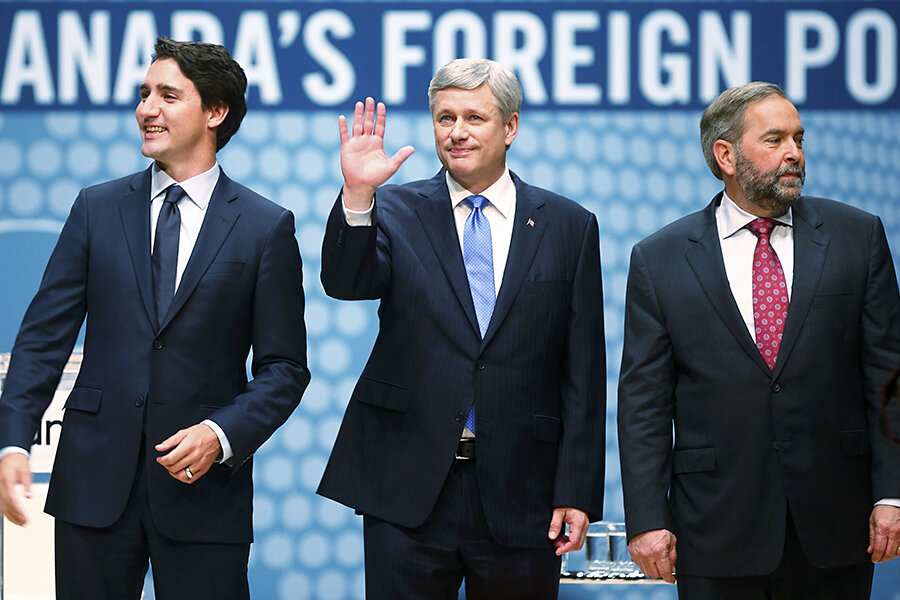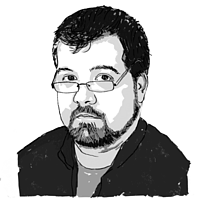Hot-button topics in the Great White North: Canada preps for the polls
Many Americans may joke about moving to Canada to avoid an uncomfortable political climate in the United States, but Canadians face similarly divisive issues – from immigration, to environmental policy, to boosting a depressed economy. Here's a look at what's at stake in Canada's election on Oct. 19.
Q: Why is this election important?
This is Canada’s federal election, which will decide the makeup of the 338-seat House of Commons, the country’s lower house of Parliament. As in the British parliamentary system, the House of Commons is Canada’s primary legislative body, and it consists of multiple parties. The party that earns the largest number of seats will have the right to form a government, and its leader will become the prime minister. Stephen Harper, leader of the Conservative Party, has been Canada’s prime minister since 2006.
Q: Who are the front-runners?
Three parties have a realistic chance at winning: the currently ruling Conservatives (Tories); the centrist Liberals, headed by Canadian political scion Justin Trudeau; and the center-left New Democratic Party (NDP) of Thomas Mulcair.
Each has been pulling around 30 percent support from the Canadian public, with most of the remainder going to smaller federal parties such as the leftist Greens and Quebec-centric Bloc Québécois. The NDP has lately begun to fall behind the Tories and Liberals over its stance against a 2011 federal ban against wearing the niqab at Canadian citizenship ceremonies.
Q: A ban of the niqab? That doesn’t seem to fit with Canada’s ‘all-embracing’ reputation.
Actually, it’s one of several hot-button issues in the race that defy Canada’s stereotypical image. In this case, the debate hinges on Zunera Ishaq, a Pakistani woman who refused to remove her veil while reciting the oath to become a Canadian citizen. She said it infringed her religious freedom. The government argued that the niqab was cultural, not religious, and that it is necessary to see aspiring citizens recite the oath.
Canada’s federal courts have repeatedly rejected the ban, agreeing with Ms. Ishaq’s interpretation. The Conservative government promised to reintroduce the ban, which it says Canadians broadly favor, should the party be reelected. Both the Liberals and NDP are adamantly against the ban, calling it racist and anti-Muslim. Importantly, the ban is supported by Bloc Québécois, earning it support in Quebec at the expense of the NDP, thereby weakening the NDP’s position nationally.
Q: What other issues are looming large in the election?
Immigration – and the Tory government’s resistance to allowing it – became a major issue after the photo of the body of Alan Kurdi, the little boy who died in the Turkish surf last month, was widely circulated. Alan’s family had intended to come to Canada, but reportedly did not meet United Nations and Canadian refugee criteria. That put Mr. Harper’s government on the defensive, as both the Liberals and NDP rolled out plans to accept tens of thousands of Syrians if elected. The Tories offered its own plan to accept 10,000 Syrians, though critics note that the government has taken in fewer than 2,500 since it first gave special priority to Syrians in 2013.
Canada also has been hotly debating its own “Patriot Act,” known as Bill C-51, which was enacted this summer. C-51 significantly expands the powers available to police and the Canadian Security Intelligence Service, with the aim of fighting terrorism. But critics say it is too vague and is susceptible to abuse of power. The bill came into law because of support from both the Tories, who fully back it, and the Liberals, who argue that it is necessary but needs further reform. The NDP, Greens, and Bloc Québécois are opposed.
Moreover, Canadians have their own “drill, baby, drill” debate about the Alberta tar sands and the Keystone XL pipeline. Harper, a notoriously vocal critic of the theory of climate change, and the Conservatives are highly keen on bringing the tar sands to market. The Liberals also support developing the tar sands and Keystone, but say that environmental regulations need to be tightened to offset any increased output. The NDP is also in favor of such offsets, but rejects Keystone outright.
Q: So what does the Canadian public actually want?
More than any of the issues above, the Canadian public cares about the economy. Much like their US neighbors, Canadians are generally pessimistic about jobs and their future financial well-being. In Canada’s case, that stems from plummeting oil prices – the country’s budget is highly dependent on energy profits – and the associated slide into recession earlier this year.
And while the Conservatives, Liberals, and NDP all claim to have the best plans for reviving the economy through some combination of tax cuts, job creation, and federal spending, none has clearly laid out a distinct economic plan. That has left the electoral horse race neck and neck – with little time left for any of the three to distinguish itself from the pack.







